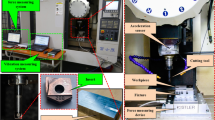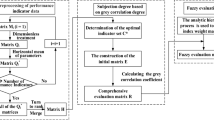Abstract
This paper presents an optimal cutting-parameter design of heavy cutting in side milling for SUS304 stainless steel. The orthogonal array with grey-fuzzy logics isapplied to optimize the side milling process with multiple performance characteristics. A grey-fuzzy reasoning grade obtained from the grey-fuzzylogics analysis is used as a performance index to determine the optimal cutting parameters. The selected cutting parameters are spindle speed, feed per tooth,axial depth of cut and radial depth of cut, while the considered performance characteristics are tool life and metal removal rate. The results ofconfirmation experiments reveal that grey-fuzzy logics can effectively acquire an optimal combination of the cutting parameters. Hence, performance in theside milling process for heavy cutting can be significantly improved through this approach.
Similar content being viewed by others
References
Tsai JC, Lin ML, Chen TY (2000) Selection of cutting parameters for high-speed machining of hardened molding alloy with maximum material removal rate in: Proc 17th Conference on CSME, pp 419–423
Juan H, Yu SF, Lee BY (2003) The optimal cutting-parameter selection of production cost in HSM for SKD61 tool steels. Int J Mach Tools Manuf 43:679–686
D’Errico GE, Gugliclmi E, Rutelli G (1999) A study of coating for end mills in high speed metal cutting. J Mater Process Technol 92–93:251–256
Tsao C-C(2002) Design optimization of cutting parameters for milling operations based on the Taguchi method. J Technol 17(4):551–557
Ghani JA, Choudhury IA, Hassan HH (2004) Application of Taguchi method in the optimization of end milling parameters. J Mater Process Technol 145:84–92
Alauddin M, El Baradie MA, Hashmi MSJ (1996) Optimization of Surface Finishing in End Milling Inconel 718. J Mater Process Technol 56:54–65
Suresh Kumar Reddy N, Venkateswara Rao P (2005) Selection of optimum tool geometry and cuttingconditions using a surface roughness prediction model for end milling. Int Adv Manuf Technol 26:1202–1210
Tolouei-Rad M, Bidhendi IM (1997) On the optimization of machining parameters for milling operations. Int J Mach Tools Manuf 37(1):1–16
TaguchiG (1990) Introduction to quality engineering. Asian Productivity Organization,Tokyo
PJ Ross (1988) Taguchi technigues for quality engineering. McGraw-Hill, New York
Kopac J (2002) Optimal machining for achieving the desired surface roughness in fine turning of coldpre-formed steel workpiece. Int J Mach Tools Manuf 42:707–716
Syrocs GP (2003) Die casting process optimization using Taguchi methods. J Mater Process Technol135:69–74
Tarng YS, Yang WH (1998) Optimization of the weld bead geometry in gas tungsten arc welding by the Taguchi method. Int J Adv Manuf Technol 14(8):549–554
Tarng YS, Ma SC, Chung LK (1995) Determination of optimal cutting parameters in wire electricaldischarge machining. Int J Mach Tools manuf 35(12):1693–1701
Deng J (1989) Introduction to grey system. J Grey Syst 1:1–24
Kao PS, Hocheng H (2003) Optimization of electrochemical polishing of stainless steel by grey relational analysis. J Mater Process Technol 140:255–259
Fung C-P (2003) Manufacturing process optimization for wear property of fiber-reinforced polybutylene terephthalate composites with greyrelational analysis. Wear 254:298–306
Shen D-H,Kuo M-F, Du J-C (2004) The application of grey relational analysis in gap-aggregate gradationaspbalt mixture design. J Grey Syst 2:115–126
Narender Singh P, Raghukandan K, Pai BC (2004) Optimization by Grey relational analysis of EDM parameters on machining Al-10% SiCp composites. J Mater Process Technol155–156:1658–1661
Lin CL, Lin JL, Ko TC (2002) Optimization of the EDM process based on the orthogonal array with fuzzylogic and grey relational analysis method. Int J Adv Manuf Technol 19:271–277
Zedeh L (1965) Fuzzy sets. Inform Control 8:338–353
Ali YM, Zhang LC (1997) Surface roughness prediction of ground components using a fuzzy logic approach. J Mater Process Technol 89–90:561–568
Lou SJ, Chen JC (1997) In- process surface recognition of a CNC milling machine using the fuzzy nets method. 21st International Conference on Computers and Industrial Engineering, 33(1–2):401–404
Liu Q, Chen X, Gindy N (2005) Fuzzy pattern recognition of AE signals for grinding burn. Int Mach Tools Manuf 45:811–818
Lin JL, Wang KS, Yan BH, Tarng YS (2000) Optimization of the electrical discharge machining process based on the Taguchi method with fuzzylogics. J Mater Process Technol 102:48–55
Hsia KH, Wu H (1998) A Study on the data preprocessing in grey relation analysis. J Chin Grey Syst Assoc 1(1):47–53
Author information
Authors and Affiliations
Corresponding author
Rights and permissions
About this article
Cite this article
Ching-Kao, C., Lu, H.S. The optimal cutting-parameter selection of heavy cutting process in side milling for SUS304 stainless steel. Int J Adv Manuf Technol 34, 440–447 (2007). https://doi.org/10.1007/s00170-006-0630-3
Received:
Accepted:
Published:
Issue Date:
DOI: https://doi.org/10.1007/s00170-006-0630-3




